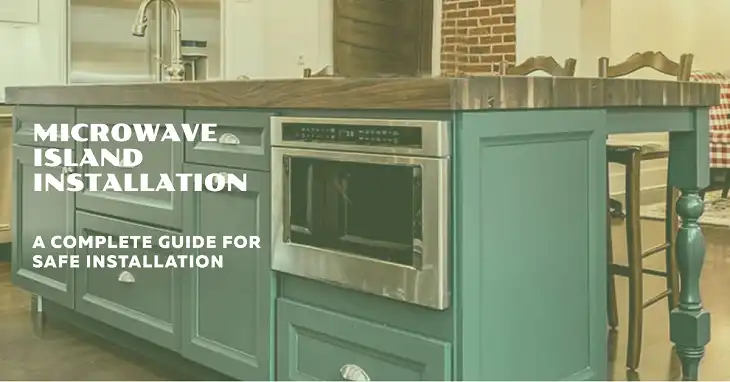How to Move a Microwave to an Island: A Complete Guide for Safe Installation

Moving a microwave to a kitchen island is a smart decision for several reasons. It not only maximizes counter space but also enhances the overall functionality of your kitchen. By placing the microwave at a central location, you make it easily accessible to everyone, especially if multiple family members use it frequently. It also creates a streamlined, modern look by keeping your countertops free of clutter. However, moving a microwave to an island isn’t just a design choice—it’s also a practical one. Whether you’re remodeling your kitchen or simply want to optimize space, relocating the microwave can free up your main cooking area and improve workflow efficiency.
What Type of Microwave Can Be Moved to an Island?
Not all microwaves are suitable for island installation. Generally, the type of microwave you choose will impact the ease of the move and installation. Countertop microwaves are the easiest to move but may require additional work to fit neatly into the island. In contrast, built-in microwaves are specifically designed for such installations and are often equipped with a trim kit for a seamless appearance. There are also microwave drawers that are ideal for islands because they open like a drawer and are designed to fit perfectly under a countertop.
Which Type of Microwave Is Best for a Kitchen Island?
The ideal option for an island setup is a built-in microwave or a microwave drawer. These units are specifically engineered for installation below eye level, ensuring both safety and aesthetics. A built-in microwave provides a flush look, while a microwave drawer offers easy accessibility without compromising on space. According to industry statistics, microwave drawers have become 35% more popular in modern kitchens due to their ergonomic benefits and sleek design.
What Are the Key Considerations Before Moving a Microwave to an Island?
- Space
Before moving your microwave, you need to measure the available space in your kitchen island. Make sure the island has enough room not just for the microwave itself, but also for proper ventilation and clearance. For a standard built-in microwave, you’ll need a cabinet opening that’s at least 24 inches wide and 15 inches deep. If you’re considering a microwave drawer, check the specifications, as these usually require around 30 inches of width.
- Island Structure
Ensure that the island is structurally sound to support the weight of the microwave. Microwaves typically weigh between 30 to 70 pounds, depending on the model. Reinforce the island if needed, especially if you plan to install a built-in unit. Make sure that the installation area can handle the weight without causing any damage or sagging.
- Right Electrical Setup
Check whether your island has a dedicated electrical outlet. Most microwaves require a 120V outlet. If your island doesn’t have one, you’ll need to hire an electrician to add it. The National Electrical Code (NEC) requires that all new installations include GFCI outlets for safety, especially in kitchen areas. This may add to your overall cost, so factor it in when planning the project.
How to Plan the Installation: Step-by-Step Preparation
To successfully move your microwave to an island, you’ll need the following:
- Measuring tape to check dimensions.
- Pencil for marking placement.
- Power drill and screws if you’re installing a built-in microwave.
- Jigsaw for cutting cabinetry (if required).
- Outlet tester to ensure the electrical setup is functional.
Having these tools ready will make the process smoother and reduce downtime.
How Do You Measure for a Proper Fit?
Start by measuring the dimensions of your microwave. Write down the width, height, and depth to ensure the island has enough space to accommodate it. Then, measure the height of the island from the floor to the countertop. For safety reasons, the microwave should be installed at a height that is easy to reach but not too low—typically between 24 to 48 inches from the floor.
Do You Need Professional Help?
If your island does not already have a dedicated outlet or if you’re unsure about cutting into cabinetry, consider hiring a professional. A contractor can help with modifications to the island and ensure the electrical setup meets safety standards. While DIY installation is possible, professional assistance will save time and minimize the risk of mistakes.
What Are the Installation Steps for Moving a Microwave to an Island?
1. Prepare the Island for Installation
Before starting the installation, make sure the island is clean and free of any obstructions. If you need to cut into the cabinetry to create an opening, use a jigsaw to make the cuts according to your microwave’s measurements. Ensure the edges are smooth to prevent damage to the microwave during installation.
2. Install the Electrical Outlet
If your island doesn’t already have a dedicated outlet, you’ll need to add one. This step typically involves hiring an electrician to run a power line through the island. Make sure the outlet is installed at the back of the opening, where it won’t interfere with the placement of the microwave.
3. Position and Secure the Microwave
Carefully place the microwave in the opening. For countertop models, you may need to add a sliding shelf for easy access. For built-in microwaves, use the provided brackets and screws to secure the unit in place. Check that the microwave is level and aligned with the surrounding cabinetry.
4. Test the Setup
Plug in the microwave and test all functions to ensure proper installation. Check for any vibrations or unusual noises, which could indicate that the unit is not securely fastened. Also, test the ventilation to confirm that there is adequate airflow around the microwave.
What Are the Common Mistakes to Avoid?
One of the most common mistakes is failing to provide adequate ventilation. Microwaves generate a lot of heat, and if the surrounding space is too tight, it can cause the unit to overheat. Make sure there’s at least 1 inch of space around the sides and 2 inches at the back for airflow.
Another frequent error is neglecting the electrical requirements. Using an existing outlet that’s shared with other high-powered appliances can lead to tripped breakers or even electrical fires. Always use a dedicated circuit for the microwave.
Lastly, avoid installing the microwave at an awkward height. If the microwave is too low, it can strain your back when reaching in to place or remove food. The ideal height is typically at waist level, making it convenient for all family members to use.
Is It Safe to Move a Microwave by Yourself?
If the microwave is a lightweight countertop model, you can easily move it yourself. However, built-in units are heavier and more cumbersome. Consider getting help if you’re moving a large microwave or making modifications to the island. According to safety guidelines, lifting heavy appliances improperly can cause back injuries or damage the unit itself.
Frequently Asked Questions (FAQs)
Can I Place Any Microwave in a Kitchen Island?
No, not all microwaves are suitable. Built-in models or microwave drawers are recommended for island installations due to their design and ventilation needs.
Do I Need a Special Outlet for an Island Microwave?
Yes, most microwaves require a dedicated 120V outlet. Check your microwave’s specifications to see if additional electrical work is needed.
How High Should a Microwave Be Installed in an Island?
Ideally, the microwave should be installed at waist height—typically between 24 to 48 inches from the floor—for easy access and safe use.



